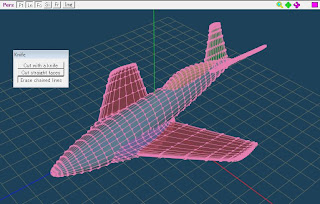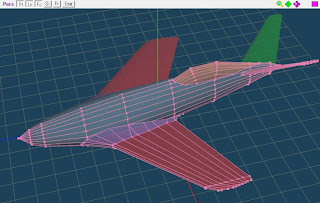Taking into account the painful lessons learned on the P.1106R's original design, I decided to throw everything away and start from scratch.
One of the most annoying things about the last design was that the cross section of the fuselage, especially at the wing root area had a complex compound curve. This made it really hard to wrap the fuselage skin around the fuselage formers. The reason why I was forced to make that weird cross section was that I had to make space for the wheel wells.Anyway, in this reboot, I'm totally aiming to keep the fuselage cross sections as simple as possible. As I move along, I'll try to find a different way to solve that issue with the wheel well.
Also, I'm going to experiment with using more b-spline patches shaping the plane.
And here it goes!
It took a bit of experimentation, but I must admit that b-spline (or catmull) patches are the way to go when you want to produce natural curvy surfaces like those on the P.1106R. Once I was happy with the shape, I let Metaseq "freeze" the patch to create a wire frame model that I can simplify and refine further.
Freezing a b-spline patch will produce the complex surfaces shown in the picture above. Although it's nice to look at, it's overkill for Pepakura (unless of course you're going to do a 1:1 scale model). But for a 1:48 scale model, I'll have to get rid of a lot of those segments. For this, I use the Knife->Erase chained lines. I'll also delete half of the model to take advantage of the mirroring function of metaseq.
After deleting excess segments, and performing the necessary boolean operations, I wound up with the picture above. So far so good!My next task would be to carve out those wheel wells and make the landing gear.




4 comments:
I wish you every success with your Me. P1106 R. :)
I am very keen to build the jet-powered version of this aircraft project, simply because of the elegant lines it has.
In my humble opinion, the combined-powered interceptor version using the BMW 003.713R rocket and jet powerplant would be extremely difficult to reproduce as a model, because the compound curves in it are even more of a nightmare than the P 1106 R you are modelling here.
That said, I do hope you will design the jet-powered version of your P. 1106 R to sit alongside your soon-to-exist model.
Kind and Respectful Regards Eric_Son, Uyraell.
Hi Uyraell,
Thanks for the words of encouragement. I'm really itching to complete this project so I can start new ones. :)
I was originally planning on making the Jet Powered P.1106R but gave up. I had a lot of trouble guestimating the curves in the fuselage where the engine exhaust tapers out. I guess it would have had a similar cross section as that of the BAC Lightning.
Hence, I chose the much simpler rocket powered version. Hehehe... I guess it wasn't as simple as I thought. :D
Eric
A better bet to study than the E.E. Lightning might have been the Bell X5 (aka Me. P.1101/1105 Mk2) or the Yak 15.
The reason for suggesting those is that in generational terms each is much nearer to the P.1106 than the E.E. aircraft, effectively a generation later, in technology terms.
The jet nozzle contours in the X5 and Yak 15 were duralumin covered in hardened sheetmetal, to deal with the high exhaust temperatures generated by the powerplants. And in the case of the X5, the exterior of the exhaust contours might not have been radically different from those intended for its' P.1106 cousin.
Kind and Respectful Regards Eric_Son my friend, Uyraell.
Good that you mentioned the P.1101. I'm thinking of copying the landing gears from that one. The Luft46.com site has a lot of illustrations on the landing gear.
I'm also considering taking a stab at the X5. Would you have any ideas on how to do swing wings on card?
Eric
Post a Comment